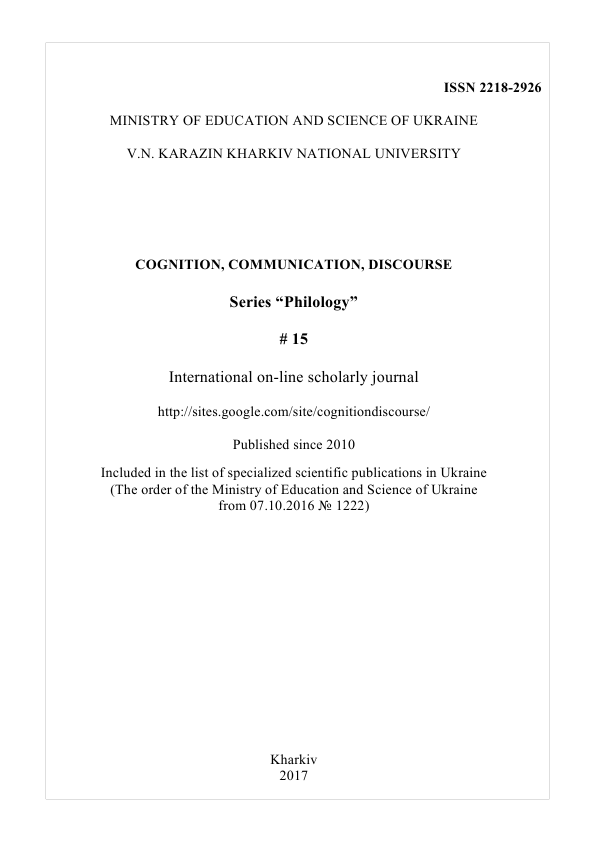Synergy of the flow of thinking
Abstract
In the paper on the basis of a hypothetical method grounded on a number of assumptions, the authors advance a new theoretical-and-methodological construct allowing a scientific consideration of the problem of the individual’s thinking self-development. The presentation of this construct is carried out with the use of verbal and graphical scientific tools, which, within the framework of classical maxims of similarity theory, make it possible to model the most important phenomena and mechanisms of their realization in the flow of thinking, viewed as a complex stochastically self-developing cognitive-and-synergetic system. The paper substantiates the elementary two-dimensional and spatial models of the self-development of human’s flow of thinking, which, according to the criterion of dominance of the fractal actualization results of its attractor-structures’ self-development, allowed the authors to single out four basic types of thinking: existential, mental, transcendental and logical ones, occurring in the corresponding spheres of a person’s spiritual life. The paper also offers the energy models for qualitative and quantitative analyses of the synergism of speaking-and-thinking and thinking-and-acting processes advanced by the authors on the basis of methods and criteria of synergetic estimation, as well as the methodology for their practical application.
Downloads
References
of synergetics]. In: V.A. Koptsik (Ed.) Sinergeticheskaja paradigma. Nelinejnoe myshlenie
v nauke i iskusstve. – Synergetic Paradigm. Non-linear thinking in science and arts (pp. 67-108). Moscow: Progress-Tradicija (in Russian).
Charlmers, D. (1996). Soznajushhij um. V poiskah fundamental'noj teorii [The conscious mind. In search of a fundamental theory]. Available from: http://romanbook.ru/book/9499372/?page=12#.
Chugaev, R.R. (1982). Gidravlika [Hydraulics]. Leningrad: Energoizdat. Publish. (in Russian).
Guhman, A.A. (1973). Vvedenie v teoriju podobija [Introduction into the theory of similarity]. Moscow: Vysshaja shkola Publish. (in Russian).
Kalyta, A.A. (2007). Aktualyzacija emocijno-pragmatychnogo potencialu [Actualization of emotional-and-pragmatic potential]. Ternopil': Pidruchnyky i posibnyky Publish. (in Ukrainian).
Kalyta, A.A., & Klymenyuk, A.V. (2004). Funkcional'no-jenergeticheskij podhod: mehanizm aktualizacii jemocional'no-pragmaticheskogo potenciala vyskazyvanija [Functional-and-energetic approach: the mechanism of the utterance’s emotional-and pragmatic potential actualiztion]. Visnyk Harkivs'kogo nacional'nogo universytetu imeni V. N. Karazina. – V.N. Karazin Natonal Univ. Messenger, 635, 70-74 (in Russian).
Kalyta, A.A. & Taranenko, L.I. (2012). Kriterij urovnja aktualizacii jemocional'no-pragmaticheskogo potenciala vyskazyvanija [Criterion of the utterance emotional-and-pragmatic potential level]. Naukovі zapiski. – Scientific notes. Kіrovograd: V. Vinnichenko State University Publish., 105 (1), 476-484 (in Russian).
Klymenyuk, A.V. (2017). Kognitivistika: problemy, predstavlenija i real'nost' [Cognitive studies: problems, ideas and reality]. Naukovі zapiski. – Scientific notes. Kropivnic'kij: Lisenko V.F. Publish. 153, 438-460 (in Russian).
Klymenyuk, O.V. (1998). Polilektyka jak filosofs'ko-metodologichne pidg'runtja kul'tury ta piznannja [Polylectics as philosophical and methodological grounds of culture and cognition]. Naukovi zapysky Ternopil'skogo derzhavnogo pedagogichnogo universytetu imeni Volodymyra Gnatjuka – Ternopil State Univ. Scientific notes. 7, 172-187 (in Ukrainian).
Kun, T. (2009). Struktura nauchnyh revoljucij [Structure of scientific revolutions]. – Moscow: AST Publish (in Russian).
Mozg Cheloveka. 4 serija [the person’s brain. Episode 4]. (2015). Available from: https://www.youtube.com/watch?v=-gaukDNm2jw
Penrouz, R. (2015). Novyj um korolja: O komp'juterah, myshlenii i zakonah fiziki [The emperor’s new mind: concerning computers, minds and the laws of physics]. Moscow: URSS: LENAND Publish. (in Russian).
Pinker, S. (2004). Jazyk kak instinkt [The language instinct]. Moscow: Editornal URSS Publish
(in Russian).
Rerih, N.K. (2011). Sem' Velikih Tajn Kosmosa [Seven great mysteries of the Space]. Moscow: Eksmo Publish. (in Russian).
Smyslov, V.V. (1978). Gidravlika i ajerodinamika [Hydraulics and aerodynamics]. – Kiev: Vishshaya shkola Publish. (in Russian).
Upravlenie real'nost'ju. Sekretnye fajly. Tajny mozga 4 [Managing the reality. Secret files. Mysteries of the brain. Episode 4]. (2014). Available from: https://www.youtube.com/watch?v=q2P8NXJcryw.
Vedenova, E.G. (2002). Arhetipy kollektivnogo bessoznatel'nogo i formirovanie teoreticheskoj nauki [The archetypes of collective unconscious and formation of a theoretical science]. In: V.A. Koptsik (Ed.) Sinergeticheskaja paradigma. Nelinejnoe myshlenie v nauke i iskusstve. – Synergetic Paradigm. Non-linear thinking in science and arts (pp. 263-273). Moscow: Progress-Tradicija (in Russian).
Vygotskij, L.S. (1982). Problemy obshhej psihologii [Problems of general psychology] In:
V.V. Davydova (Ed.) Sobranie sochinenij v 6-ti t. – Collection of works in 6 volumes. Moscow: Pedagogika Publish. 2 (in Russian).
Bak, P. (1996). How nature works. The science of self-organized criticality. N.Y.: Copernicus.
Deeke, L., Grotzinger, B., & Kornhuber, H.H. (1976). Voluntary finger movements in man: cerebral potentials and theory. Biol. Cybernetics, 23, 99-119.
Haken, H. (2004). Synergetics: Introduction and Advanced Topics. Berlin: Springer.
Libet, B., Wright, E.W. Jr., Feinstein, B., & Peari, D.K. (1979). Subjective referral of the timing for a conscious sensory experience: a functional role for the somatosensory specific projection system in man. Brain, 102 (1), 193-224.
Authors, who publish with this journal, accept the following conditions:
The authors reserve the copyright of their work and transfer to the journal the right of the first publication of this work under the terms of the Creative Commons Attribution License (CC BY), which allows other persons to freely distribute a published work with mandatory reference to the authors of the original work and the first publication of the work in this journal.
Authors have the right to enter into separate additional agreements for the non-exclusive dissemination of the work in the form in which it was published by this journal (for example, to post the work in the electronic institutions' repository or to publish as part of a monograph), provided that the link to the first publication of the work in this journal is given.
The journal policy allows and encourages the authors to place the manuscripts on the Internet (for example, in the institutions' repositories or on personal websites), both before the presentation of this manuscript to the editorial board and during review procedure, as it contributes to the creation of productive scientific discussion and positively affects the efficiency and dynamics of citing the published work (see The Effect of Open Access).




